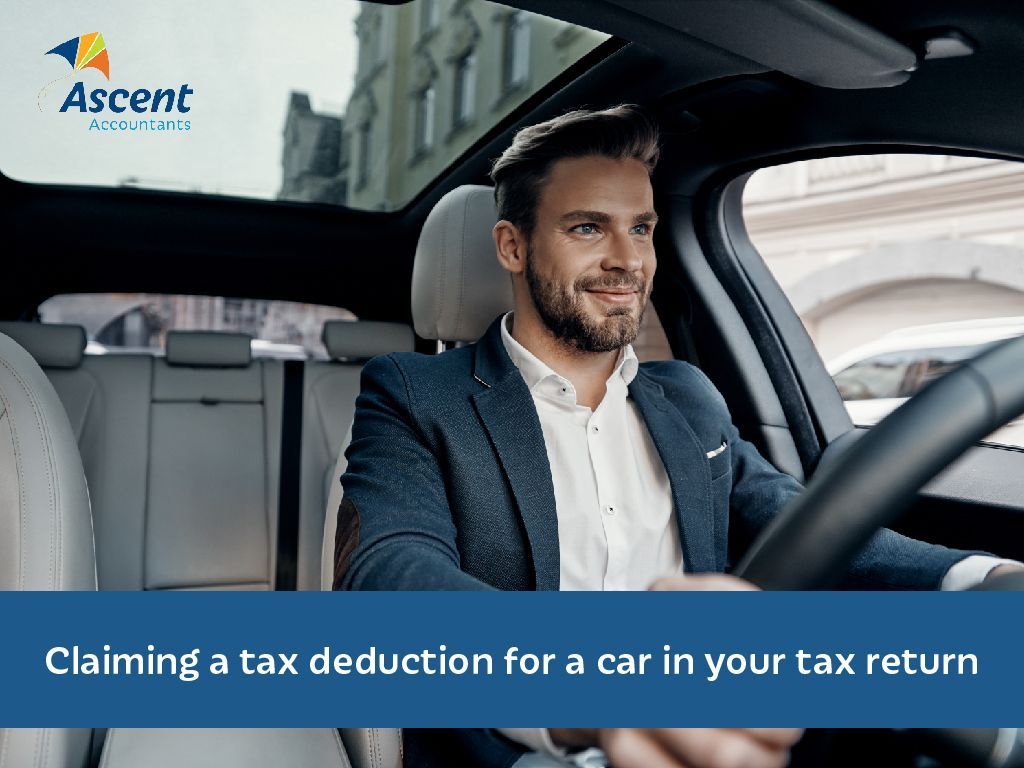Claiming a tax deduction for a car in your tax return

Like many business owners, you might enjoy the benefits of a company car, but did you know this affects your tax return?
Wait, what’s a “car” again?
To claim a work-related car expense, the vehicle must be a car by the ATO’s definition: “a motor vehicle that carries a load of less than one tonne and fewer than nine passengers (including the driver)”. You can claim for vehicles other than a car, such as a motorbike or truck, but this article specifically pertains to tax deductions for car use within a business.
See if you qualify.
1. You must own or lease the car.
To claim car expenses, you must own or lease the car, or hire it under a hire-purchase arrangement. You do not own or lease the car if you use it under a salary sacrifice or novated lease arrangement. In this situation, the car is usually leased by your employer from a financing company, and your employer pays for the running costs and claims deductions.
2. You must use the car for work purposes.
This means you can claim for trips between workplaces or to perform your work duties. You can't claim for trips between your home and place of work, except in limited circumstances.
You must have spent the money yourself and weren't reimbursed, and have the required records to prove it (for example, receipts for petrol). If you receive an allowance from your employer for car expenses, you must include it as assessable income in your tax return. The allowance amount is shown on your income statement or payment summary.
If you travel for work but then also engage in personal activities while you’re there (e.g. driving to a restaurant for dinner), you can only claim a deduction for the work-related portion of your expenses.
How to calculate car expenses.
There are two methods you can use to calculate your car expenses. The cent/km method or the logbook method. If you are claiming car expenses for more than one car, you can use a different method for each car depending on what works best for your circumstances. You can also change the method you use in different income years for the same car.
1. Cents/km method.
You can claim a maximum of 5,000 work-related kilometres per car. If you and another joint owner use the car for separate income-producing purposes, you can each claim up to 5,000 work-related kilometres.
To calculate your deduction using this method, multiply the number of work-related kilometres (the kilometres your car travels in the course of earning your income) you travel by the rate per kilometre for that income year. The rate for the 2023–24 income year is 85 cents/km. The rate for the 2022-2023 income year is 78 cents/km. The cents per kilometre rate covers the car’s decline in value, registration, insurance, maintenance, repairs, and fuel costs.
If you use this method, you don't need receipts. However, you do need to be able to show that you own the car and how you work out your work-related kilometres. For example, you could record your work-related trips in a diary or using the myDeductions tool in the ATO app.
2. Logbook method.
To calculate your deduction using the logbook method, you need to keep a logbook that shows your work-related trips for a continuous period of at least 12 weeks. Your logbook must include the destination and purpose of every journey, the odometer reading at the start and end of each journey, and the total kilometres travelled during the period. If you are using the logbook method for multiple cars, you’ll need a separate logbook for each car — make sure they cover the same period.
You can keep an electronic logbook using the myDeductions tool in the ATO app, or keep a paper logbook. Either way, your logbook is valid for five years, and you must retain your logbook and odometer records for five years after the end of the latest income year that you rely on them.
You also need to keep receipts (or similar records) or all work-related car expenses. This includes receipts for registration, insurance, lease payments, services, tyres, repairs, electricity expenses and interest charges. Petrol and oil expenses — or a record of your reasonable estimate of these expenses based on the odometer readings for the start and end of the period for which you are claiming — also need to be kept. You must also record the purchase price of the car and how you work out your claim for the decline in value of your car, including the effective life and method you use.
Then, use your logbook to calculate the deductible portion of your car expenses:
- Work out the total number of kilometres you travelled during the logbook period.
- Work out the number of kilometres you travelled for allowable work-related trips during the logbook period.
- Divide the work-related kilometres by the total kilometres, then multiply by 100. This is your work-related use percentage.
- Add up your total expenses for the period for which you are claiming.
- Multiply your work-related use percentage by your car expenses. This is the amount you claim as a deduction.
Want more support when it comes to car claims?
Australian tax laws can be incredibly confusing, and it can be difficult to keep up with how these laws affect your work vehicle use. If you're claiming work-related car expenses, we can help you with a logbook to ensure you’re claiming the maximum amount at tax time. So,
contact us today.
Need help with your accounting?








